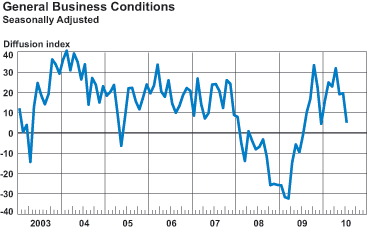July 2010 Report
Survey Indicators
Seasonally Adjusted

The Empire State Manufacturing Survey indicates that while conditions for New York manufacturers continued to improve in July, the pace of growth in business activity slowed substantially over the month. The general business conditions index remained positive but fell 15 points, to 5.1.The new orders and shipments indexes were also positive but lower than last month’s levels. Employment indexes dipped as well, with the average workweek index falling below zero for the first time this year. The prices paid index was positive and held steady, while the prices received index declined to a level just below zero. The future general business conditions index was little changed, remaining close to its May and June levels but below the highs seen earlier in the year. The index for future number of employees fell markedly, although it remained above zero. The capital spending and technology spending indexes were also positive, but both were well below the peak levels reached in May.
In a series of supplementary questions, manufacturers were asked to estimate the percentage changes in their sales and employment levels from 2009 to 2010—both year to date and for the calendar year. In this year’s survey, the median respondent reported that sales were up 7 percent for the first half of 2010 and were expected to be up 8 percent for the full calendar year—a stark contrast with the results of last July’s survey, when the median respondent reported 15 percent declines for the corresponding time horizons in 2009. In the current survey, the number of employees was reported to be unchanged in the first half of the year and was expected to remain so over the full year. In the 2009 survey, 10 percent declines were seen for both horizons. Respondents were also queried about the contribution of exports to firm revenues and about firm efforts to market abroad. In general, respondents indicated that exports accounted for a growing share of their revenues; their firms were devoting more resources to marketing abroad—particularly in Asia—and were expecting sales to be higher in the next 12 months than in the past 12 months across all parts of the world.
Growth of Business Activity Slows
The general business conditions index remained positive but fell from 19.6 to 5.1 in July, indicating that conditions had improved at a significantly slower pace than in June. The index has fallen a cumulative 27 points from the 2010 peak of 31.9 reached in April. This month, 27 percent of respondents said that conditions had improved, while 22 percent said that conditions had worsened. The new orders index dropped 7 points to 10.1, and the shipments index fell 13 points to 6.3. The unfilled orders index declined 15 points to -15.9, its lowest level since December. The delivery time index turned negative, a sign that delivery times had shortened. The inventories index rose from a level near zero to 6.4, suggesting that inventory levels had increased after holding steady in May and June.
Input Prices Flat, Workweek Declines
The prices paid index, at 25.4, was little changed from last month; the pace of price increases in June and July was well below that seen in April and May. The prices received index fell from 4.9 to a level just below zero, suggesting that the prices manufacturers received for their products remained fairly constant this month, with nearly 80 percent of respondents indicating that their prices did not change. The index for number of employees drifted downward for a second consecutive month, falling from 22.4 in May to 12.4 in June, and then to 7.9 in July. This pattern suggests that employment levels did increase over the month, but at a slower pace than in the previous two months. The average workweek index dropped 18 points and, at -9.5, entered negative territory for the first time this year. Twenty-two percent of respondents said that the average workweek had shortened while 13 percent said that it had lengthened.
Outlook Still Positive, but Many Future Indexes Fall
Future indexes generally remained positive, but the degree of optimism about the six-month outlook weakened somewhat in July. The future general business conditions index was little changed; at 41.3, it hovered near its May and June levels, off from the highs recorded earlier in the year. The future new orders index was also little changed, while the future shipments index dipped several points, to 31.8. The future prices paid index held steady at 41.3, while the future prices received index fell 11 points to 17.5. Future employment indexes were noticeably lower. The index for future number of employees was still positive—indicating that employment levels were expected to be higher in six months—but it fell 14 points, to 14.3, its lowest level since September of last year. The future average workweek index dropped to a level just below zero. The capital expenditures index declined for a second consecutive month, falling 14 points to 14.3, its lowest level in a year. The technology spending index also declined to its lowest level in a year, dipping 9 points to 4.8.










